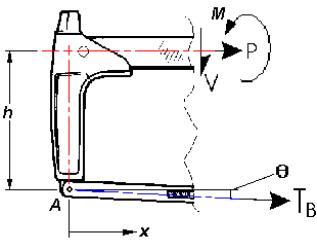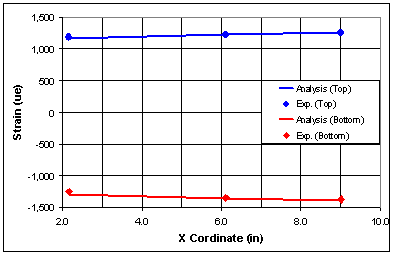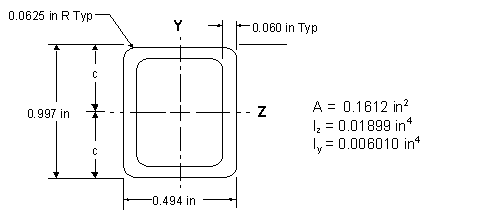Volume 1, Number 2, Spring 2001
A Combined Stress Experiment Using a
Hacksaw
Marshall F. Coyle
Pennsylvania State University-York
1031 Edgecomb Ave.
York, PA 17403-3398
Email: mfc5@psu
Christal G. Keel
Pennsylvania State University-York
Email: christal@keel.org
ABSTRACT
This paper describes
a laboratory experiment that can be used to demonstrate combined stresses
to engineering students in Strength of Materials classes. A typical hand-held
hacksaw is used to illustrate combined normal stresses due to bending and
axial loading. A commercially available handsaw is loaded statically by tension
in the saw blade. The tensile load on the hacksaw blade results in both bending
and axial compressive stresses in the backbone of the hacksaw. This study
demonstrates the experimental technique of using strain gages to validate
an analytical solution, as well as the concept of creating and calibrating
a load transducer to measure the applied load. This paper presents details
on the analysis, experimental approach, and the results.
INTRODUCTION
The purpose of the experiment
is to demonstrate a basic concept of combine stresses that engineering students
typically encounter in their first Strength of Materials class. C-clamps,
coping saws, and hacksaws are popular examples of combine stress problems
presented in textbooks1, 2. This paper differs from other laboratory
experiments3, 4 using C-clamps in that its goal is to demonstrate
the validation of an analytical approach. This not only helps to further students’
understanding of combined stress but also demonstrates the experimental validation
portion of the design circle.
Figure 1 illustrates a
typically constructed hand-held hacksaw.

Figure
1: Typical Hacksaw.
The head, handle, and
backbone make up the frame of the hacksaw. The rigidity of the frame places the
blade in tension in order to prevent buckling due to the slenderness of the
blade. When a tensile force is applied to the blade, the head and handle
portions of the saw see a resulting tension. These forces produce both axial
compressive forces and bending forces in the backbone of the saw. A Stanley
contractor grade high-tension saw was chosen for this experiment, due to the
following characteristics:
- It has a quick blade tightener/release
mechanism that facilitates a rapid and easily repeatable loading and unloading
of the blade.
- The blade tension is adjustable up to
340 lb.
- The backbone consists of rectangular,
chrome-plated steel tubing that allows for the effective application of strain
gages.
- The distance between the centerline of
the saw blade and the backbone varies linearly, with the smaller distance
occurring at the head. This causes the bending moment to vary along the length
of the saw and makes for a more interesting analysis.
THEORY

Figure
2: Free body diagram of saw head and backbone.
Figure 2 is a Free
Body Diagram (FBD) of an arbitrary section taken through the saw. The shear
force (V), bending moment (M), and axial force (P) are all shown as being in the
positive direction for the standard beam convention. The blade is a two-force
member that produces a point load applied at point A. Since the blade sits in the frame at
a slight angle (q), the resultant force
will have X and Y components. The tensile force in the
blade (TB) is counteracted
by both an axial compressive force (P) and a shear force (V) in the backbone. This axial
compressive force serves to balance the horizontal component of the tensile
force (TB) while the shear
force (V) balances the vertical
component.
SFx =
0
(1)
P + TB *
cos(q) = 0
P = -TB *
cos(q)
SFy = 0
(2)
-V - TB * sin(q) = 0
V = -TB * sin(q)
Because both the
horizontal and vertical components of TB being applied at point A are eccentric to the axis of the
backbone a bending moment (M) is
produced. It is calculated as follows:
SMA = 0 (3)
M – P * h – V * x =
0
M = P * h + V * x
M = -TB * cos(q) * h – TB * sin(q) * x
where h is the vertical distance from point A to the neutral axis of the backbone
and x is the horizontal distance from
point A to the location of the
section. Figure 3 shows the cross-section of the backbone. The axial stress
(sA) in the backbone is
calculated by dividing the resultant compressive force (P) by the cross sectional area of the
backbone (A):
sA = P/ A
(4)
Figure
3: Cross-sectional drawing of the backbone.
The bending moment
produces a bending stress (sB), which is tensile on
the top and compressive on the bottom surfaces of the saw’s backbone. We can now
use the flexure formula to calculate the bending stresses:
sB = ± M * c /
Iz
(5)
where c is the distance from the neutral axis
to the outer surfaces of the backbone as illustrated in Figure 3, and IZ is the moment of inertia
about the Z-axis.
The strains on the top
(e
top) and the bottom
(e
bottom) of the backbone are
calculated by dividing the combined stresses by the modulus of elasticity (E = 29.0E6 psi for
steel):
e top =
(sB-top
+ sA) / E
(6)
e bottom
= (sB-bottom
+ sA) / E
(7)
EXPERIMENTAL VERIFICATION
I. Instrumentation:
The Stanley High-Tension
Hacksaw was instrumented with eight Measurements Group, Inc. EA-06-240LZ-120
Student Gages. The strain gage locations are shown in Figure 4 and listed
in Table 1.

Figure
4: Mounting locations of strain gages
Table
1: Gage Locations
|
Gage No. |
X
(in) |
Description |
|
1 |
6 |
Front of saw
blade |
|
2 |
6 |
Back of saw
blade |
|
3 |
2.164 |
Top of
backbone |
|
4 |
2.164 |
Bottom of
backbone |
|
5 |
6.111 |
Top of
backbone |
|
6 |
6.111 |
Bottom of
backbone |
|
7 |
9.017 |
Top of
backbone |
|
8 |
9.017 |
Bottom of
backbone |
The backbone is
instrumented with six strain gages, three along the top surface, and three along
the bottom surface of the backbone. Two strain gages are also located on the saw
blade, since it is used as a load transducer. The strain gages on the saw blade
were placed back-to-back on the front and backsides of the saw blade in order to
average out any effects due to bending in the saw blade. The gages were bonded
to the hacksaw with a Measurements Group, Inc. M-Bond 200 cyanoacrylate adhesive system. Strain gage
readings were taken using Measurements Group, Inc. P-3500 Portable Strain
Indicator with a SB-10 Switch and Balance Unit.
II. Load Transducer Calibration:
Calibration of the load
transducer was accomplished by acquiring strain gage readings for various
tensile loads. The instrumented saw blade was placed in a test frame shown
in Figure 5 and instrumented with a 0-5,000 kg dynamometer. The transducer
was loaded from 0 to 551 lb in 55.1 lb increments, and strain gage readings
were taken at each increment. A linear regression analysis was performed on
the calibration data. Figure 6 presents the results from the load transducer
calibration showing a plot of the load versus strain. It can be seen from
the plot that the behavior of the load transducer is linear.

Figure
5: Photograph of test frame set-up.

Figure 6: Load
Transducer Behavior.
III.
Experimental Procedure:
The saw blade (load
transducer) was positioned on the hacksaw attachment pins, which were located
on the head and handle of the saw as illustrated in Figure 1. The strain gage
balance unit was used to zero all the strain gage readings. Tension was then
applied to the saw blade by using the saw’s tensioning mechanism. The strain
gage readings from the loaded hacksaw were recorded, at which point the tension
was removed from the blade. Strain gage readings were taken after the load
was removed to determine instrumentation drift, which was found to be a maximum
of 6 µe. This test procedure
was replicated four times.
DISCUSSION OF RESULTS
There was good agreement
between the experimental and the analytical results for all four experimental
replications. The applied load varied from 304.5 to 306.7 lb among the replications,
which produced slightly different analytical and experimental results. The
difference between the analytical and experimental results was consistent
between the four replications. It varied less than 0.90 % for each location
between replications; therefore, only the results from one replication are
presented. The analytical and experimental results from one of the experiments
are tabulated in Table 2 and graphically shown in Figure 7.
Table 2: Analytical
and Experimental Results
|
Gage No. |
Analytical
Results |
Experimental
Strain |
Difference
(Analytical/ Experimental) | |||
|
Bending
Stress (psi) |
Axial
Stress (psi) |
Combined
Stress (psi) |
Strain | |||
|
3 |
35,408 |
-1,893 |
33,514 |
1,156 |
1,179 |
-1.98
% |
|
4 |
-35,408 |
-1,893 |
-37,301 |
-1,286 |
-1,256 |
-2.41
% |
|
5 |
36,971 |
-1,893 |
35,078 |
1,210 |
1,217 |
-0.61
% |
|
6 |
-36,971 |
-1,893 |
-38,864 |
-1,340 |
-1,353 |
0.95
% |
|
7 |
38,122 |
-1,893 |
36,229 |
1,249 |
1,247 |
0.18
% |
|
8 |
-38,122 |
-1,893 |
-40,015 |
-1,380 |
-1,374 |
-0.43
% |

Figure 7: Analytical and Experimental
Results
The results presented
in Table 2 and Figure 7 come from a test having a test load (TB) of 305.5 lb. Results
show there is good agreement between the analytical and experimental results.
The greatest difference was –2.41 %, which occurred at gage #4. The difference
between the analytical and experimental results is due to gage location measurements
that were taken. Errors in measurement h shown in Figure 2 will affect the
analytical solution the most.
SUMMARY
A simple hand-held hacksaw
that most people are probably familiar with was used to demonstrate the concepts
of axial, bending, and combined stresses and strains. This paper outlined
an analytical procedure for calculating the stresses and strains in the backbone
of a conventional hacksaw. The analytical results were then verified experimentally.
This paper gives details on the experimental procedure using strain gages
to validate the analytical solution. Finally, analytical and experimental
results are presented showing that there is good agreement between the two.
REFERENCES
1.
Applied Strength of Materials, 3rd edition, by Robert L. Mott, MacMillan Publishing,
pp. 421-422, 1996. ISBN 0-13-376278-5.
2.
Mechanics of Materials, 4th edition, by R.C. Hibbeler, Prentice Hall, pp.
434-437, 2000. ISBN 0-13-016467-4.
3.
Of Clamps & Spring & Things:
http://www.measurementsgroup.com/guide/notebook/e22/e22.htm,
Measurements Group, Inc., last accessed April 17, 2001.
4.
A Strength of Materials Laboratory
Experiment: http://et.nmsu.edu/~etti/spring98/mechanical/magill/magill.html,
Michael
A. Magill, Ph.D., P.E., last accessed April 17,
2001.

